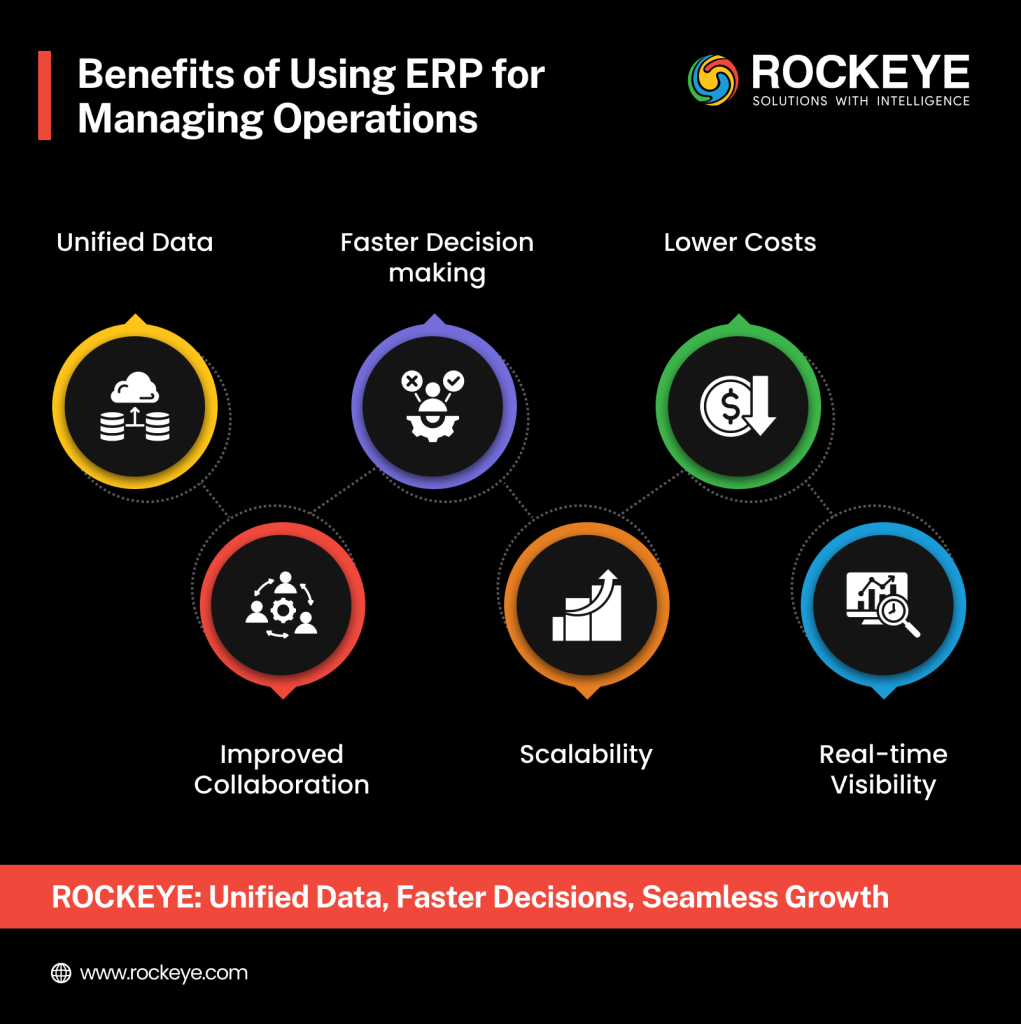Quick Summary
If you’re juggling multiple tools for finance, inventory, HR, sales, and customer service, you’re not running your business; you’re firefighting. This “tool chaos” eats away time, creates errors, and slows down growth. In this blog, we’ll break down the hidden cost of managing operations in silos, explore why ERP (Enterprise Resource Planning) systems solve this problem, and show how ROCKEYE, a cognitive ERP software, can bring order, speed, and clarity to your business operations.
Table of Contents
Why Multiple Tools = Operational Chaos
You’ve got:
- A CRM for sales
- A separate invoicing app for finance
- An inventory tracker
- A project management tool
- An HR system
All great tools individually… But together?
They’re a tangled web of logins, exports, imports, and “Who updated this last?” conversations.
Every day, you switch between screens, copy-paste data, and chase down reports from different systems. It’s not just tiring; it’s expensive, and it silently slows your business growth.
Think about it: When your finance team sees different numbers than your sales team, when inventory updates lag by a day, or when customer support can’t see order details instantly, you’re making decisions based on incomplete or outdated information.
The Hidden Cost of Using 5+ Different Tools

It’s not just the subscription fees; the real cost is in productivity, accuracy, and missed opportunities.
- Wasted Time
Employees waste hours logging into different tools, searching for files, or reconciling conflicting data. Over a year, that’s weeks of lost productivity.
- Data Silos & Mismatched Reports
When your systems don’t talk to each other, data lives in isolated pockets. The result? Reports that don’t match, KPIs that can’t be trusted, and decisions based on guesswork.
- Higher Operational Costs
Each tool needs maintenance, integrations, and sometimes even dedicated people to manage them. Multiply that across five tools, and you’re burning money.
- Poor Collaboration
If marketing doesn’t have the same customer view as sales, and finance doesn’t see the latest deal pipeline, collaboration suffers.
- Missed Opportunities
When data isn’t centralized, spotting trends, predicting demand, or identifying high-value customers becomes nearly impossible.

The Signs You’re Living in “Tool Chaos”
You might be in operational chaos if:
- You spend more time collecting data than analyzing it.
- Your monthly reports take days to prepare.
- Teams complain about “not having visibility” into other departments.
- Customers get inconsistent updates or have to repeat information.
- Decisions are delayed because you need to “check with another system.”
What a Cloud Based ERP System Really Does
ERP (Enterprise Resource Planning) isn’t a magic word; it’s a single platform that connects all your key business processes in one place. Instead of separate tools for finance, HR, sales, inventory, and projects, a cloud-based ERP solution combines them into one connected system where:
- Data updates in real time across all departments
- You get one login, one dashboard, and one source of truth
- Everyone works from the same live information
Think of it as the central nervous system of your business; it senses, connects, and responds instantly.
Benefits of Using ERP for Managing Operations
Here’s why cloud-based ERP software beats juggling multiple tools:
- Unified Data
Everyone works from the same live information, updated instantly across all departments. No more mismatched reports or duplicate entries, just one reliable source of truth for your entire business.
- Faster Decision-making
Generate accurate, up-to-the-minute reports in seconds instead of waiting days. With all data connected, leaders can spot opportunities, address risks, and act quickly without waiting for manual updates.
- Lower Costs
One system replaces multiple software subscriptions, costly integrations, and maintenance overhead. By streamlining your tech stack, you save money while reducing the hidden costs of inefficiency and rework.
- Improved Collaboration
All teams operate on the same platform, with instant access to shared information. Departments can work together effortlessly, reducing back-and-forth communication delays and ensuring everyone stays aligned on goals.
- Scalability
Expand your business without adding operational complexity. Easily add new departments, locations, products, or services within the ERP, keeping everything connected as your organization grows and evolves.
- Real-time Visibility
Monitor sales, inventory, projects, and finances as they happen. Live dashboards give you a clear picture of performance at any moment, so you can respond to changes immediately.
How ROCKEYE ERP Can Help You Break the Chaos Cycle
ROCKEYE, a cloud ERP for small businesses, is built for businesses tired of running in circles with multiple tools. Here’s how it changes the game:
- All-in-one Dashboard – See sales, inventory, projects, and finances at a glance.
- Customizable Workflows – No “one-size-fits-all”, tailor processes to your needs.
- Seamless Integrations – Connect with existing tools you still want to keep.
- Real-Time Data Sync – No more double-entry or outdated spreadsheets.
- Scalable for Growth – Add modules as your business expands.
- User-friendly Design – Your team actually wants to use it.
With ROCKEYE ERP, you replace five scattered tools with one connected powerhouse that simplifies your entire operation.
Dive In: Cloud-based ERP System: The Future of Business Efficiency
Real-World Scenarios: From Chaos to Control
Before ERP:
A manufacturing company used separate tools for inventory, accounting, CRM, and project management. Inventory updates lagged 24 hours, causing stockouts. Finance and sales numbers never matched.
After ROCKEYE ERP:
All processes are connected in one system. Inventory updated in real time, finance reports pulled instantly, and sales could promise delivery dates with confidence. Result: 25% faster order processing and zero stockouts.
Making the Shift: How to Transition Without Disruption
Switching from multiple tools to ERP sounds scary, but it doesn’t have to be.
Step 1: Audit your current processes and tools
Review every system, workflow, and tool you use today. Identify gaps, overlaps, and inefficiencies that slow operations or create confusion across departments.
Step 2: Identify what can be consolidated into ERP
List functions that can move into ERP, such as finance, inventory, HR, or sales. The goal is to centralize operations without losing essential capabilities.
Step 3: Migrate in phases; start with the most critical processes
Begin with high-impact areas where ERP will deliver the fastest results. This phased approach reduces disruption and ensures smoother adoption across the organization.
Step 4: Train teams to adopt the new system
Provide role-based training so employees understand exactly how ERP benefits their work. When teams see the value, adoption and productivity naturally increase.
Step 5: Monitor and optimize
Continuously track ERP performance and gather user feedback. Adjust workflows, add modules, and fine-tune processes to maximize efficiency as your business grows and evolves.
With the right partner, ERP migration can be smooth, fast, and minimally disruptive.

FAQs
1. Is ERP too expensive for small businesses?
Not anymore. Modern ERP systems like ROCKEYE offer modular pricing so you only pay for what you need.
2. Will I have to stop using all my existing tools?
No. ERP can integrate with tools you still need, so you can transition gradually.
3. How long does ERP implementation take?
It depends on complexity, but small to mid-sized businesses can be live within weeks.
4. What if my team resists the change?
Involve them early, show how it saves time, and provide training — adoption rates go up when people see real benefits.
5. Can ERP help with remote work?
Absolutely. ERP centralizes data in the cloud, so your team can access it from anywhere, anytime.
6. What are the real disadvantages of managing operations with multiple disconnected tools?
When you rely on five or more different tools for core functions like finance, HR, sales, inventory, and customer service, you’re essentially creating information islands. Data lives in separate silos, which means teams can’t see the same version of the truth. This leads to duplicated work, inconsistent reporting, and slower decision-making. In the long run, you also spend more on subscriptions, integrations, and IT support to keep these tools talking to each other, and they still won’t work as seamlessly as a single integrated ERP like ROCKEYE.
7. How does ERP help improve collaboration between teams?
An ERP system connects every department to the same centralized platform. Sales can instantly see what’s in stock, finance can check the latest deals without chasing the sales team, and customer service can view order histories in real time. This means less “email back and forth” and more acting on accurate data. With ROCKEYE ERP, collaboration isn’t just about chatting; it’s about everyone working from the same live dashboard, so there’s zero guesswork.
8. Will ERP replace all my existing software, or can it work with them?
ERP doesn’t have to be an all-or-nothing switch. A modern ERP like ROCKEYE is modular, meaning you can start with just the features you need and integrate it with other tools you still want to keep. For example, if you love your CRM but want better financial and inventory control, ROCKEYE can integrate with your CRM while managing other processes under one roof. Over time, you can consolidate more tools into the ERP to simplify your stack.
9. How do I know if my business is ready for ERP?
If you’re spending more time gathering data than using it, struggling with mismatched reports, or facing bottlenecks because systems don’t sync in real time, you’re ready. Another big sign is rapid growth: the more teams, locations, or products you add, the faster tool chaos grows. ERP prevents that chaos from scaling with you. ROCKEYE ERP is particularly suited for businesses in the scaling phase that need flexibility without adding complexity.
10. How can ERP help with decision-making?
In a disconnected setup, decision-making is like looking in the rear-view mirror; you’re always reacting to old data. ERP provides real-time visibility into every part of your business: sales, stock levels, cash flow, and customer trends. This means you can forecast demand, spot problems early, and act on opportunities faster. ROCKEYE ERP even allows for custom dashboards so leaders can see exactly what matters to them the moment they log in.
11. Is ERP only for large enterprises, or can SMBs benefit too?
ERP used to be something only Fortune 500 companies could afford. That’s changed. Cloud-based ERP software like ROCKEYE is built for flexibility, so even small businesses can start with just a few modules and expand over time. In fact, SMBs often see faster ROI because ERP eliminates the inefficiencies that hit smaller teams the hardest.
Conclusion: It’s Time to Take Control
Managing operations across 5 different tools isn’t just inconvenient; it’s costing you time, money, and growth. The longer you wait to unify your processes, the more inefficiencies pile up.
ROCKEYE ERP gives you the clarity, speed, and control you need to grow without the chaos.
The cost of chaos is real. The solution is simple.

